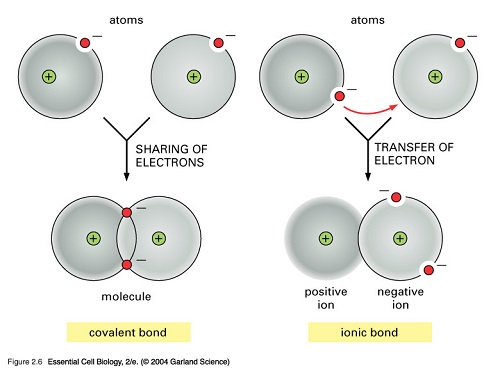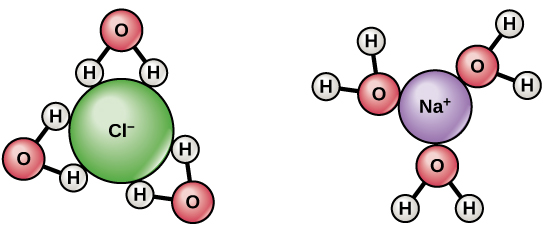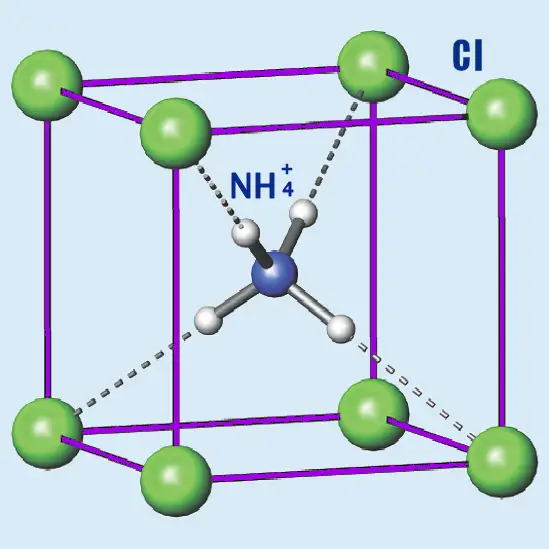What is Ionic Bond? Definition and few Characteristics
The ionic bond occurs between the atoms of elements with a big difference in their electronegativity. When the atoms of such elements interact one of them provides and the other one accepts electrons and they turn into oppositely charged ions. The ionic bond results from the electrostatic interaction of the ions.
Unlike the covalent bond, the ionic one is not directed, due to the fact that the electric field generated by the ions has a spherical symmetry. All compounds with ionic bonds are crystalline substances. The whole crystal can be considered as a giant molecule consisting of many ions. Only in a gaseous state, at high temperature, there may be separate, not associated molecules. The ionic bond occurs between atoms of chemical elements of opposite chemical nature – metallic and nonmetallic. The ionic chemical bond is very strong and it is difficult to be torn.
Ionic bond in which one atom completely shares an electron with another does not exist: the ionic compounds have a certain degree of electron sharing. The bonds are considered ionic when the ionic character is bigger than the covalent one, i.e. a bond with a large electronegativity difference.
Sodium chloride is an example of a compound with an ionic bond. The single electrons of the Sodium and Chloride atoms form a common electron pair. The Chlorine atom attracts the pair and becomes a negative ion, the Sodium atom becomes a positive one:
2Na + Cl2 → 2Na+Cl–

What is Covalent Bond? Definition and few characteristics
The covalent bond is a chemical bond executed by common electron pairs belonging to both atoms. Through it, the bonding of atoms occurs both in molecules and in crystals. It occurs both between the same atoms, for example in the molecules of Cl2, O2, diamond, etc., and between different atoms in the molecules of H2O, NH3, etc. In all organic compounds, the bonds are covalent. Particular features of the covalent bond are its direction and its saturated character. The covalent bonds can be nonpolar or polar, depending on the location of the area of increased electronic density.
In the case of homonuclear (composed of equal atoms) two-atom molecules such as H2, N2, etc., the increased electronic density is located symmetrically to the nuclei of the atoms. The centers of the positive and negative charges coincide. Such a connection is called a non-polar covalent bond. When the connecting atoms are of different electronegativity, the electron density is drawn off as a result of stronger pulling to the core of the more electronegative atom and the bond is a covalent polar. Examples of such bond are HF and HCl. The strength of the covalent bonds is determined by the energy that is produced when they are formed. The bond is stronger and harder to tear if more energy is generated during formation.
The covalent bonds are simple and complex. A bond is simple when only one common pair is formed between the two atoms. Complex bonds are formed with two or more common electronic pairs.
Example for a covalent bond is the one between the atoms of hydrogen.
H+H → H:H
What are the similarities between Ionic Bonds and Covalent Bonds?
Similarities in terms of ‘Bonding’ between Ionic and Covalent Bonds
- Both ionic and covalent bonding involve different number of atoms coming together and forming more complex structures. They are strong bonds.
Similarities in terms of ‘Compound formation’ between Ionic and Covalent Bonds
- Both types of bonding result in forming of compounds with different properties from the bonding sources.
Similarities in terms of ‘Energy’ between Ionic and Covalent Bonds
- The main reason for the bonding is the decrease of the energy of the atoms, because the bodies with lower energy are more stable.
Similarities in terms of ‘Exothermic’ between Ionic and Covalent Bonds
- Ionic and covalent bonding is exothermic, due to the fact that the energy of the participants is lowered.
Similarities in terms of ‘electronic pair’ between Ionic and Covalent Bonds
- Both types of bonding are carried out by a common electronic pair.
Similarities in terms of ‘electrostatic force ‘ between Ionic and Covalent Bonds
- Ionic and covalent bonding is induced by electrostatic force.
Similarities in terms of ‘Neutrality ‘ between Ionic and Covalent Bonds
- The net charge of the compounds, formed by ionic and covalent bonds is neutral.
Ionic and Covalent Bonds : Summary
- The ionic bond arises between the atoms of elements with a big difference in their electronegativity. When the atoms of such elements interact one of them provides and the other one accepts electrons and they turn into oppositely charged ions. The ionic bond results from the electrostatic interaction of the ions.
- The covalent bond is a chemical bond executed by common electron pairs belonging to both atoms.
- Ionic and covalent bonding involves different number of atoms coming together and forming more complex structures. The formed compounds have different properties from the bonding sources.
- The main reason for the bonding is the decrease of the energy of the atoms, because the bodies with lower energy are more stable.
- Ionic and covalent bonding is induced by electrostatic force. The net charge of the compounds, formed by ionic and covalent bonds is neutral.
Author: Dr. Mariam Bozhilova
Dr. Mariam Bozhilova has a Master’s degree in Ecology and PhD in Botany. Her main professional interests are in the fields of ecology, biology and chemistry. She has more than 10 years of professional experience in scientific research and environmental consultancy.











Leave a Reply